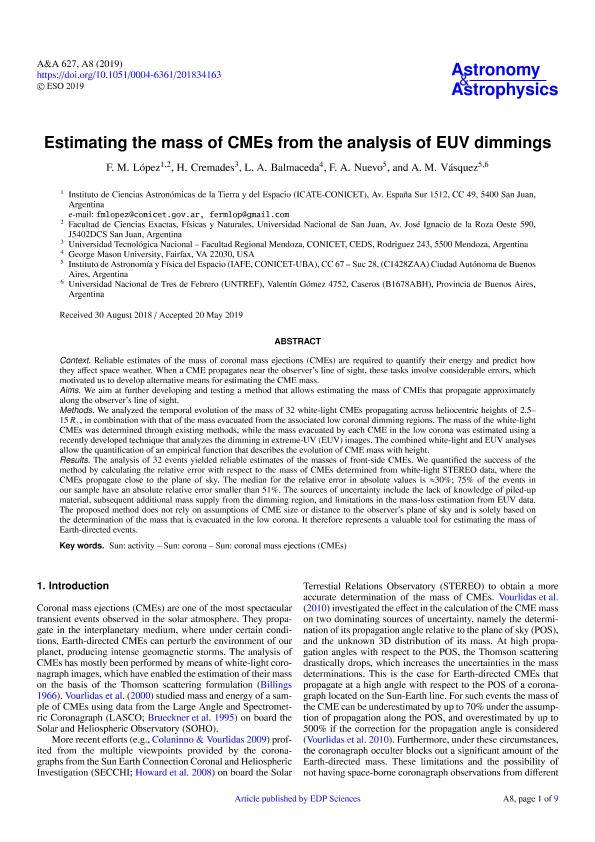Mostrar el registro sencillo del ítem
dc.contributor.author
López, F. M.
dc.contributor.author
Cremades Fernandez, Maria Hebe

dc.contributor.author
Balmaceda, Laura Antonia

dc.contributor.author
Nuevo, Federico Alberto

dc.contributor.author
Vásquez, A. M.
dc.date.available
2020-03-11T17:50:42Z
dc.date.issued
2019-07
dc.identifier.citation
López, F. M.; Cremades Fernandez, Maria Hebe; Balmaceda, Laura Antonia; Nuevo, Federico Alberto; Vásquez, A. M.; Estimating the mass of CMEs from the analysis of EUV dimmings; EDP Sciences; Astronomy and Astrophysics; 627; 28; 7-2019; 1-9
dc.identifier.issn
0004-6361
dc.identifier.uri
http://hdl.handle.net/11336/99152
dc.description.abstract
Context. Reliable estimates of the mass of coronal mass ejections (CMEs) are required to quantify their energy and predict how they affect space weather. When a CME propagates near the observer's line of sight, these tasks involve considerable errors, which motivated us to develop alternative means for estimating the CME mass. Aims. We aim at further developing and testing a method that allows estimating the mass of CMEs that propagate approximately along the observer's line of sight. Methods. We analyzed the temporal evolution of the mass of 32 white-light CMEs propagating across heliocentric heights of 2.5-15 R, in combination with that of the mass evacuated from the associated low coronal dimming regions. The mass of the white-light CMEs was determined through existing methods, while the mass evacuated by each CME in the low corona was estimated using a recently developed technique that analyzes the dimming in extreme-UV (EUV) images. The combined white-light and EUV analyses allow the quantification of an empirical function that describes the evolution of CME mass with height. Results. The analysis of 32 events yielded reliable estimates of the masses of front-side CMEs. We quantified the success of the method by calculating the relative error with respect to the mass of CMEs determined from white-light STEREO data, where the CMEs propagate close to the plane of sky. The median for the relative error in absolute values is ≈30%; 75% of the events in our sample have an absolute relative error smaller than 51%. The sources of uncertainty include the lack of knowledge of piled-up material, subsequent additional mass supply from the dimming region, and limitations in the mass-loss estimation from EUV data. The proposed method does not rely on assumptions of CME size or distance to the observer's plane of sky and is solely based on the determination of the mass that is evacuated in the low corona. It therefore represents a valuable tool for estimating the mass of Earth-directed events.
dc.format
application/pdf
dc.language.iso
eng
dc.publisher
EDP Sciences

dc.rights
info:eu-repo/semantics/openAccess
dc.rights.uri
https://creativecommons.org/licenses/by-nc-sa/2.5/ar/
dc.subject
SUN: ACTIVITY
dc.subject
SUN: CORONA
dc.subject
SUN: CORONAL MASS EJECTIONS (CMES)
dc.subject.classification
Astronomía

dc.subject.classification
Ciencias Físicas

dc.subject.classification
CIENCIAS NATURALES Y EXACTAS

dc.title
Estimating the mass of CMEs from the analysis of EUV dimmings
dc.type
info:eu-repo/semantics/article
dc.type
info:ar-repo/semantics/artículo
dc.type
info:eu-repo/semantics/publishedVersion
dc.date.updated
2019-12-11T20:20:18Z
dc.journal.volume
627
dc.journal.number
28
dc.journal.pagination
1-9
dc.journal.pais
Francia

dc.description.fil
Fil: López, F. M.. Consejo Nacional de Investigaciones Científicas y Técnicas. Centro Científico Tecnológico Conicet - San Juan. Instituto de Ciencias Astronómicas, de la Tierra y del Espacio. Universidad Nacional de San Juan. Instituto de Ciencias Astronómicas, de la Tierra y del Espacio; Argentina
dc.description.fil
Fil: Cremades Fernandez, Maria Hebe. Consejo Nacional de Investigaciones Científicas y Técnicas; Argentina. Universidad Tecnológica Nacional; Argentina
dc.description.fil
Fil: Balmaceda, Laura Antonia. George Mason University; Estados Unidos. Consejo Nacional de Investigaciones Científicas y Técnicas. Centro Científico Tecnológico Conicet - San Juan. Instituto de Ciencias Astronómicas, de la Tierra y del Espacio. Universidad Nacional de San Juan. Instituto de Ciencias Astronómicas, de la Tierra y del Espacio; Argentina
dc.description.fil
Fil: Nuevo, Federico Alberto. Consejo Nacional de Investigaciónes Científicas y Técnicas. Oficina de Coordinación Administrativa Ciudad Universitaria. Instituto de Astronomía y Física del Espacio. - Universidad de Buenos Aires. Facultad de Ciencias Exactas y Naturales. Instituto de Astronomía y Física del Espacio; Argentina
dc.description.fil
Fil: Vásquez, A. M.. Consejo Nacional de Investigaciónes Científicas y Técnicas. Oficina de Coordinación Administrativa Ciudad Universitaria. Instituto de Astronomía y Física del Espacio. - Universidad de Buenos Aires. Facultad de Ciencias Exactas y Naturales. Instituto de Astronomía y Física del Espacio; Argentina. Universidad Nacional de Tres de Febrero; Argentina
dc.journal.title
Astronomy and Astrophysics

dc.relation.alternativeid
info:eu-repo/semantics/altIdentifier/url/https://www.aanda.org/articles/aa/abs/2019/07/aa34163-18/aa34163-18.html
dc.relation.alternativeid
info:eu-repo/semantics/altIdentifier/doi/http://dx.doi.org/10.1051/0004-6361/201834163
Archivos asociados
